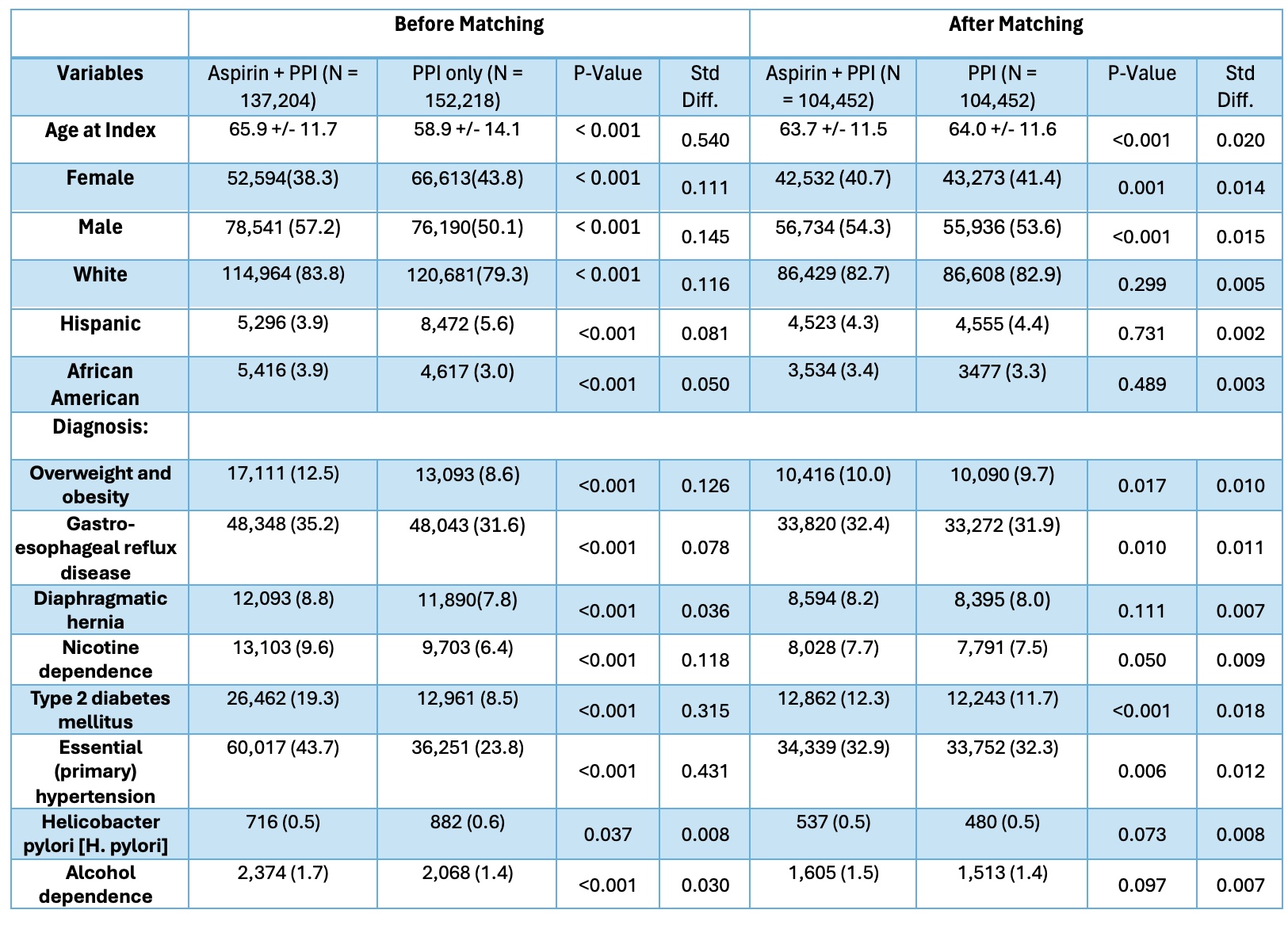Sunday Poster Session
Category: Esophagus
P0643 - Aspirin Plus Proton Pump Inhibitor Therapy Reduces Progression to Esophageal Adenocarcinoma in Barrett’s Esophagus: A Real-World Propensity-Matched Cohort Study
Sunday, October 26, 2025
3:30 PM - 7:00 PM PDT
Location: Exhibit Hall

Ismail Elkhattib, MBBCh
University of Nebraska
Hartford, CT
Presenting Author(s)
Ismail Elkhattib, MBBCh1, Mohamed A. B. Elnaggar, MD2, Basant Elsayed, MBBCh3, Azizullah Beran, MD4, Khaled Elfert, MD5
1University of Nebraska, Hartford, CT; 2Hartford Healthcare, Hartford, CT; 3Ain Shams University, Cairo, Ad Daqahliyah, Egypt; 4Indiana University School of Medicine, Indianapolis, IN; 5West Virginia University School of Medicine, Morgantown, WV
Introduction:
Barrett's esophagus (BE) is a precancerous condition associated with increased risk of progression to esophageal adenocarcinoma (EAC). Aspirin and proton pump inhibitors (PPIs) have been investigated for their potential chemopreventive effects in BE. Real-world comparative data between combination aspirin plus PPI therapy versus PPI monotherapy for preventing progression to esophageal adenocarcinoma remain limited.
Methods:
We conducted a retrospective cohort study using the TriNetX US Collaborative Network, a federated electronic health record database. Adult patients with BE who were treated with aspirin plus PPI or PPI alone were identified. Patients with high-grade dysplasia were excluded from the analysis. Propensity score matching (1:1) was performed on demographics (age, gender, race), comorbidities (overweight and obesity, gastroesophageal reflux disease, diaphragmatic hernia, nicotine dependence, type 2 diabetes mellitus, essential hypertension, Helicobacter pylori infection, and alcohol dependence). The primary outcome was progression to EAC during follow-up.
Results:
A total of 137,204 patients in the aspirin plus PPI cohort and 152,218 patients in the PPI-only cohort met inclusion criteria. After propensity score matching, 104,452 patients remained in each cohort with well-balanced baseline characteristics. The mean age was 63.7 ± 11.5 years in the aspirin plus PPI group and 64.0 ± 11.6 years in the PPI-only group. At follow-up, progression to EAC occurred in 304 patients (0.291%) in the aspirin plus PPI group compared to 402 patients (0.386%) in the PPI-only group. The combination therapy was associated with a significant risk reduction (Risk Ratio = 0.754, 95% CI: 0.650-0.875, Risk Difference = -0.095%, 95% CI: -0.145% to -0.045%, p = 0.0002).
Discussion: In this real-world analysis, treatment with aspirin plus PPI was associated with lower rates of progression to EAC compared to PPI monotherapy in patients with BE over the study period. The 0.095% absolute risk reduction and 24.6% relative risk reduction demonstrate a clinically meaningful chemopreventive benefit of combination therapy. The highly significant p-value (p = 0.0002) provides strong statistical evidence for this protective effect. These findings support the role of aspirin as an adjunctive chemopreventive agent in BE management, suggesting that the anti-inflammatory and antiplatelet properties of aspirin may provide additional protection beyond acid suppression alone.

Figure: Table 1. Baseline characteristics of Aspirin and PPI cohort versus PPI only cohort before and after propensity-score matching
Disclosures:
Ismail Elkhattib indicated no relevant financial relationships.
Mohamed A. Elnaggar indicated no relevant financial relationships.
Basant Elsayed indicated no relevant financial relationships.
Azizullah Beran indicated no relevant financial relationships.
Khaled Elfert indicated no relevant financial relationships.
Ismail Elkhattib, MBBCh1, Mohamed A. B. Elnaggar, MD2, Basant Elsayed, MBBCh3, Azizullah Beran, MD4, Khaled Elfert, MD5. P0643 - Aspirin Plus Proton Pump Inhibitor Therapy Reduces Progression to Esophageal Adenocarcinoma in Barrett’s Esophagus: A Real-World Propensity-Matched Cohort Study, ACG 2025 Annual Scientific Meeting Abstracts. Phoenix, AZ: American College of Gastroenterology.
1University of Nebraska, Hartford, CT; 2Hartford Healthcare, Hartford, CT; 3Ain Shams University, Cairo, Ad Daqahliyah, Egypt; 4Indiana University School of Medicine, Indianapolis, IN; 5West Virginia University School of Medicine, Morgantown, WV
Introduction:
Barrett's esophagus (BE) is a precancerous condition associated with increased risk of progression to esophageal adenocarcinoma (EAC). Aspirin and proton pump inhibitors (PPIs) have been investigated for their potential chemopreventive effects in BE. Real-world comparative data between combination aspirin plus PPI therapy versus PPI monotherapy for preventing progression to esophageal adenocarcinoma remain limited.
Methods:
We conducted a retrospective cohort study using the TriNetX US Collaborative Network, a federated electronic health record database. Adult patients with BE who were treated with aspirin plus PPI or PPI alone were identified. Patients with high-grade dysplasia were excluded from the analysis. Propensity score matching (1:1) was performed on demographics (age, gender, race), comorbidities (overweight and obesity, gastroesophageal reflux disease, diaphragmatic hernia, nicotine dependence, type 2 diabetes mellitus, essential hypertension, Helicobacter pylori infection, and alcohol dependence). The primary outcome was progression to EAC during follow-up.
Results:
A total of 137,204 patients in the aspirin plus PPI cohort and 152,218 patients in the PPI-only cohort met inclusion criteria. After propensity score matching, 104,452 patients remained in each cohort with well-balanced baseline characteristics. The mean age was 63.7 ± 11.5 years in the aspirin plus PPI group and 64.0 ± 11.6 years in the PPI-only group. At follow-up, progression to EAC occurred in 304 patients (0.291%) in the aspirin plus PPI group compared to 402 patients (0.386%) in the PPI-only group. The combination therapy was associated with a significant risk reduction (Risk Ratio = 0.754, 95% CI: 0.650-0.875, Risk Difference = -0.095%, 95% CI: -0.145% to -0.045%, p = 0.0002).
Discussion: In this real-world analysis, treatment with aspirin plus PPI was associated with lower rates of progression to EAC compared to PPI monotherapy in patients with BE over the study period. The 0.095% absolute risk reduction and 24.6% relative risk reduction demonstrate a clinically meaningful chemopreventive benefit of combination therapy. The highly significant p-value (p = 0.0002) provides strong statistical evidence for this protective effect. These findings support the role of aspirin as an adjunctive chemopreventive agent in BE management, suggesting that the anti-inflammatory and antiplatelet properties of aspirin may provide additional protection beyond acid suppression alone.

Figure: Table 1. Baseline characteristics of Aspirin and PPI cohort versus PPI only cohort before and after propensity-score matching
Disclosures:
Ismail Elkhattib indicated no relevant financial relationships.
Mohamed A. Elnaggar indicated no relevant financial relationships.
Basant Elsayed indicated no relevant financial relationships.
Azizullah Beran indicated no relevant financial relationships.
Khaled Elfert indicated no relevant financial relationships.
Ismail Elkhattib, MBBCh1, Mohamed A. B. Elnaggar, MD2, Basant Elsayed, MBBCh3, Azizullah Beran, MD4, Khaled Elfert, MD5. P0643 - Aspirin Plus Proton Pump Inhibitor Therapy Reduces Progression to Esophageal Adenocarcinoma in Barrett’s Esophagus: A Real-World Propensity-Matched Cohort Study, ACG 2025 Annual Scientific Meeting Abstracts. Phoenix, AZ: American College of Gastroenterology.
